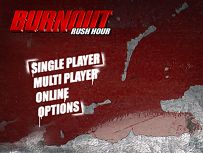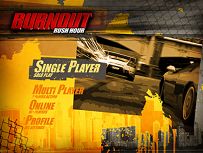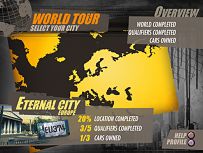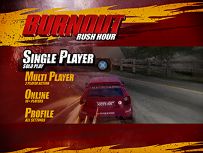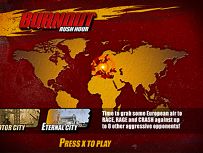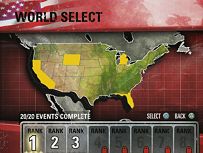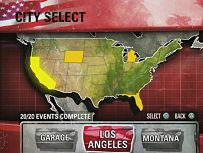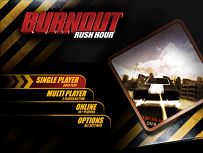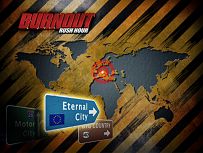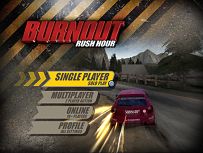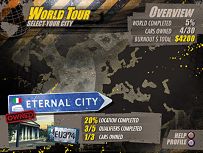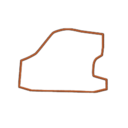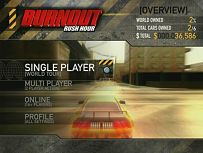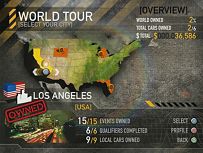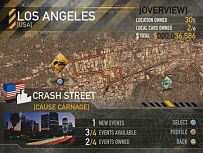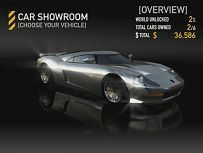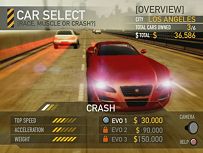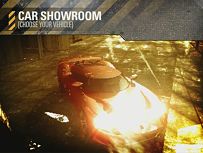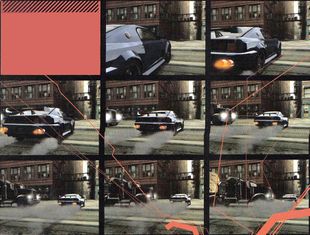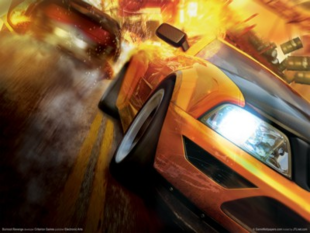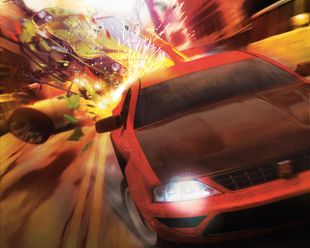Prerelease:Burnout Revenge (PlayStation 2, Xbox)
This page details pre-release information and/or media for Burnout Revenge (PlayStation 2, Xbox).
| This article is a work in progress. ...Well, all the articles here are, in a way. But this one moreso, and the article may contain incomplete information and editor's notes. |
| To do: Need to grab a few more images. |
Contents
Burnout Rush Hour
Before it was called Revenge, it was called Rush Hour. A bunch of images and clips on Criterion's old website show some early concepts and screens for menus, as well as their line of thinking behind making these.
1st Concept Style
The initial concept style, where the text is sprayed on a wrecked car. This particular style was not developed on further as it looked too simplistic.
2nd Concept Style
Taking ideas of the urban style from the 1st concept. The gameplay video shown on the right was also desaturated and colorized in a way to make it sit more in line with the background. The world map used angular cutouts.
This design ended up looking too cluttered, and when attempting to scale it down, it lost its core Burnout values, and eventually also abandoned.
3rd Concept Style
This style took inspiration from a Japanese player guide to Burnout 3. It uses beaten metal as the base texture, and the colors are very contrasting. This is also the first instance where the horizontal carousel was introduced as the primary method of navigation.
Upon deciding it was too bright and stylised for Burnout, they experimented with a few more styles. At this stage of development, the game had a Garage button in the menu, which has an unused texture that has survived into the final release.
4th Concept Style
Now the design is starting to look more and more familiar, with the introduction of chevrons. Translating the chevron style to the world map, however, wasn't as successful, as they dominate the view over the actual world map.
What's interesting to note is the gameplay clip used on the main menu has some debug text visible on-screen, listing memory statistics. The gameplay clip also uses the Muscle Type 1 from Burnout 3: Takedown, probably for testing purposes.
Lastly, the chevrons were toned down by mixing them together with scuffed road textures. This is more or less of what ended up being used in the end.
Development Screenshots
Screenshots taken in development. Still quite different from what ended up being in the final game, but the garage icon can be seen in use on the 3rd screenshot. It has a similar icon design to the unused texture found in the final game. It also has an orange track outline visible, of which one texture has also survived into the final game. The unused “MAINMENU.m2v” video can be seen for the main menu.
Car Select
One of the initial car selects were very minimal, clean, and reflective, but this didn't express what Burnout stood for. Then the 2nd pass was an AI speeding through a highway in the oncoming lane, and changing vehicles on the spot. The final pass is for the most part what ended up in the final game - a car in a warehouse.
The original metadata for these two videos indicate they were made throughout March 2005.
- carselect_freeway.mov – 2005-03-08T15:35:24.000000Z (Right video)
- carselect_minimal.mov – 2005-03-29T13:38:35.000000Z (Left video)
Pre-E3
A couple of short clips from a build of the game predating the E3 version and presumed to be from April 2005; strangely, IGN claims this footage is from Electronic Arts' Hot Summer Nights event and GameSpot claims it's from E3 2005, however the former event would have taken place during June/July 2005, and the game's appearance at E3 postdates this footage by at least a month.
- Minus the sporadic bouncing, crash physics are still very similar to Burnout 3's.
- Crash cameras were also identical to Burnout 3's, and takedown cameras were identical to the E3 build.
E3 2005 Trailer
This trailer would appear in the final game.
- HUD isn't present.
- The "Takedown!" message isn't present.
- Takedown sounds were different.
E3 2005 Build
A playable prototype build of the game appeared at E3 2005 that bears quite a few similarities to Revenge's various demo builds.
Cameras
- Crash cameras used to lock onto your car and follow it as it crashes, similar to Burnout 3, but positioned a little further. This camera still exists and is used in the final game, but only when you use the Crashbreaker in a race without taking anyone down. The camera in the final game is viewed from the perspective of what appears to be a cameraman, judging by its movement, and will face the wreck. Sometimes it will change into another perspective or view the crash from the car's hood or rear end (similar to the main menu cameras) before switching to the "cameraman" perspective.
- Takedown cameras would shift to the taken-down rival's car and follow it in slow motion as he wrecks, similar to Burnout 3 and again, positioned a little further. In the final game the slow motion is kept, but the takedown camera angles have expanded. The afterward shot showing the takedown in a fixed third-person angle was in both earlier and final versions.
- Crash Mode originally had the exact same camera behavior as Burnout 3's crash mode and the screen would shake whenever you crash landed or simply crashed. The final game has multiple camera angles similar to a helicopter and another one similar to a "cameraman" viewed from third person perspective.
Crash Mode
- This version of Crash Mode uses a simple end-to-end bar instead of the golf swing meter of later versions, and timing it right would get you a "Power Boost" instead of a Perfect Start.
- Power Boosts certainly live up to their name, seeing as though they practically launched cars off the starting line at top speed as opposed to the much weaker effect of Perfect Starts.
- A Crashbreaker pickup can be seen; this along with the Cash Pickups' appearance in the game's trailer (also made during the E3 era) confirms pickups had not yet been removed. The pickups' functions can still be implemented in the final game, although without a texture.
- Cars that caught fire would explode when hit.
- Crashbreaker could be activated by just pressing the button.
Traffic Attack
- This version of Traffic Attack gave significantly more run-up time before the timer started ticking down (99 seconds as opposed to the final game's 40 seconds).
- The timer bar used a green-to-red color scheme as opposed to the final game's yellow-to-red.
Miscellaneous
- If an opponent slams the player into a same way traffic car that normally can be checked, the player would crash.
Crashbreaker Race
Some footage of Crashbreaker Race events from Gamespot and Gamekult.
- Some sound effects are different.
- Score is visible.
- The ranking system looked completely different.
- The rating system is missing.
Alex Ward Interview
This is an interview with the creator and director of the Burnout series, Alex Ward. It's dated 6th July 2005. A lot of elements from Alpha 7 can be seen in this.
- The Rating System looked and worked differently.
- The Car Select Screen was unfinished and lacked car information.
- Score can be seen when you perform a Revenge Takedown.
Cut/Changed Cars
Mustang
This car, which heavily resembles the fifth-generation (S197) Ford Mustang GTR, was cut sometime after April 2005 for unknown reasons; possibly to avoid potential lawsuits.
Early Designs
The Criterion M-Type's front fascia was completely different.
| Early | Final |
|---|---|

|
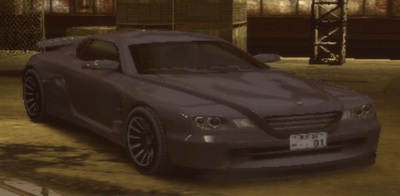
|
The Stock C170 Mid had a substantially different design; interestingly enough, certain parts of it were very similar to Burnout 3's Muscle Type 1 (hood scoop, lower half of the front fascia, fender edges, and even mirrors and door handles).
| Early | Final |
|---|---|
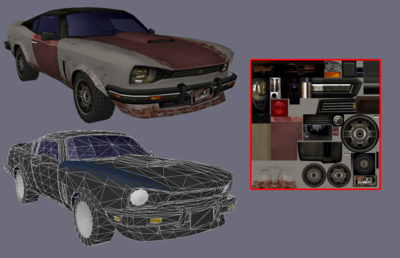
|

|
The Stock C170's early design shows up again in this screenshot, as well as early designs for the Factory R160 ST (red car on the right) and the Works R170 ST (yellow car on the far right).
- This very same screenshot confirms there were drivers in the game at some point. They appeared in Burnout 3: Takedown and Burnout Legends, but in Burnout Revenge the car seats are empty (except for the Logitech World Racer and Nixon Special, the game's formula cars).
Some of the game's loading screens consist of concept art showing numerous muscle-looking vehicles with a grill at the rear end and square-shaped taillights. No such vehicle exists in the final game, however.
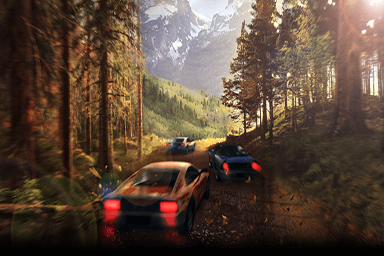
|
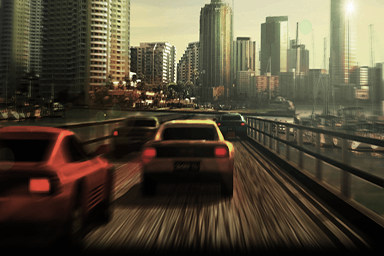
|
| LoadSc27.bin\loading27\Image27_01; 02; 03.tif | LoadSc31.bin\loading31\Image31_01; 02; 03.tif |
- In a concept render, there is the Etnies Racer. It appears different than in the actual game, being taller and with a yellow stripe along the grill. Also, in the "Serial Pillar" signature takedown video, it had the Burnout 3 model, but with the Etnies paint job.

|
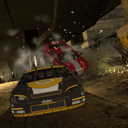
|
|
| LoadSc14.bin\loading14\Image14_01; 02; 03.tif | FeMain.bin\b4polaroid\Detroit_pillar.tif | S_DT03_N/P.xmv/.M2V + Movies.xwb/.RWS\MoviesP1\11 |
Track Changes
Proven by concept renders in loading screens, event selection icons, and its appearance in the Alpha 7 prototype, Sunshine Keys was going to take place in the very late afternoon/sunset, as opposed to morning in the final version. Central Route was also going to take place at night, proven again by its selection icon.
Minor Stuff
- There were originally Mountain Dew billboards in the game, but they were removed for unknown reasons. Licensing, perhaps?
- Crash exclusive vehicles could be used outside of Crash Mode. A screenshot shows a Crash vehicle racing along with a Factory R160 ST and some other cars.
- The PlayStation 2/Xbox versions originally had the Xbox 360 exclusive Crash junctions. Some of the yellow ramps from the Xbox 360 crash junctions can still be seen on the older versions, but cannot be accessed.
- Sunshine Keys was meant to have more Crash junctions. A good example is the Crash training movie, which shows off the cut junction "Beach Bash".
